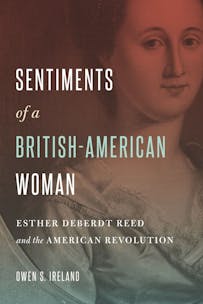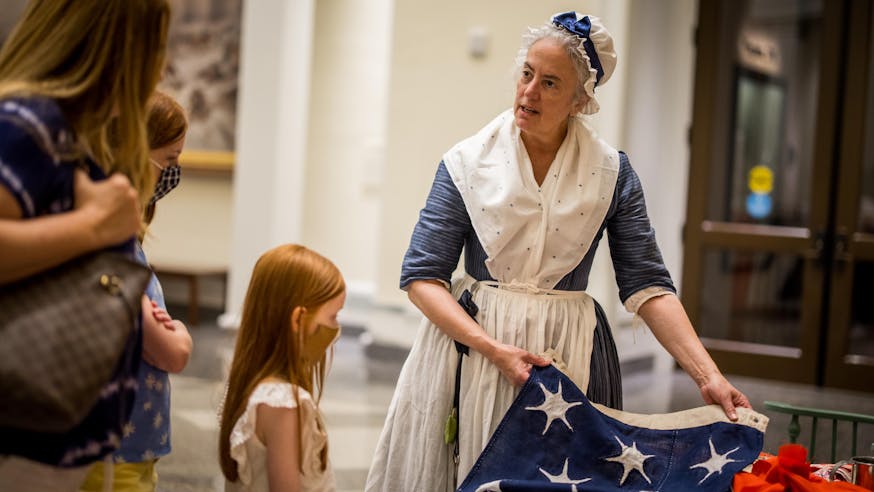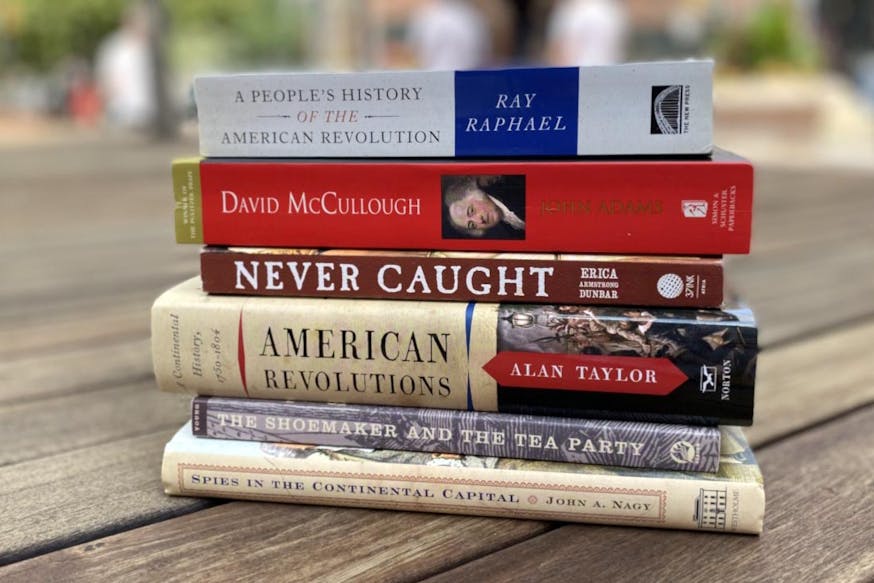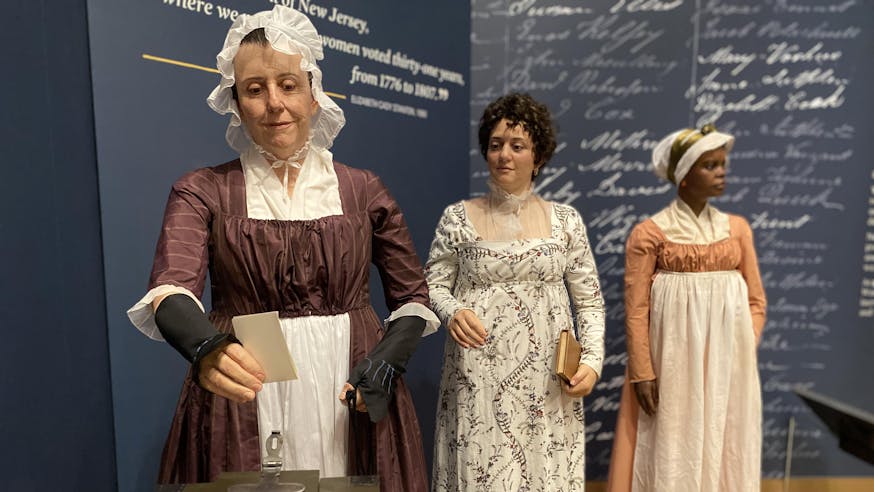Read the Revolution
Sentiments of a British-American Woman
April 27, 2022
Purchase the book from Penn State University Press.
Seventeen-year-old Englishwoman Esther de Berdt met (and by all historical accounts, fell in love with) Joseph Reed, an ambitious law student from New Jersey, in London, 1763. After five years of a long-distance courtship by mail, without parental approval, the young couple married only to face an unexpected tragedy that exiled them to build a home in Philadelphia. There, historian Owen S. Ireland argues in Sentiments of a British-American Woman: Esther DeBerdt Reed and the American Revolution, she applied her English upbringing, knowledge of international commerce, religious convictions, and social skills to become a political operative, publicist, and the author of “The Sentiments of an American Woman,” a 1780 treatise that taught generations of women how to translate their political responsibilities into action. Esther de Berdt Reed is honored by this biography as “one of the most important women in Revolutionary America.”
Living in Philadelphia, Esther de Berdt Reed independently concluded that she would support the American struggle for independence and collaborated with Joseph Reed to advance their national political leadership. In perhaps her most famous fundraiser, she organized fellow Philadelphia women through her Ladies Association of Philadelphia to collect money door-to-door from over 1,500 Philadelphia households. Throughout the project, she debated with George Washington himself about how the money would be spent. The Association finally purchased linen and produced over 2,000 shirts for Washington’s soldiers, starting in June 1780 and finishing in just three months. Each shirt was personally signed by the maker as a symbol of her support for their efforts.
Read an excerpt from Chapter 11: America’s Female Politician to learn about Reed’s reasoning behind the notable political activities that she accomplished before her untimely death in September 1780.
Excerpt
Esther led the way with her most impressive political “event” of the summer: the door-to-door solicitation by the Ladies Association to raise money for American soldiers, planning for which had begun well before the birth of the new baby. More substantial but no less symbolic and efficacious than [George Washington Reed’s] christening, "the first large-scale women's association in American history" made Esther one of Americas best-known female patriot leaders. She personified it. She was its focal point, its driving force, its organizational genius, and its public face, first in Philadelphia, then in the countryside and in time as far north as Massachusetts and as far south as Virginia. In this success, she demonstrated her skill in organizing large-scale public political events, her ability to operate in a democratic and fractured polity, and her insight into the on-the-ground gender ideals against which patriot women measured themselves.
On Saturday, June 10, 1780, an anonymous broadside, "The Sentiments of an American Woman,” initiated the campaign of the Ladies Association. A single-page printed sheet of about one thousand words (similar to a piece of modern political campaign literature), "The Sentiments" appealed to the women of the city to join in its effort to raise money for the men in the Continental Army.
The timing of the publication of the broadside is interesting. It appeared in the papers on Saturday. The next day, women throughout the city would gather for Sunday worship. No venue in the city provided a better location for face-to-face exchange among significant numbers of women, and the speed with which the women responded in the first few days of the new week suggests that the Saturday call by "The Sentiments" was much discussed on Sunday.
The popular response among patriot women was instant, electric, and amazing. As one woman described it to her friend: "Those who were in the country returned without delay... others put off their departure; those whose state of health was the most delicate, found strength in their patriotism, one lady... having an infant too young to leave... was soon relieved from her distress by a lady ... generously offering to nurse it during her absence."
Sign Up!
Get biweekly Read the Revolution featured excerpts right to your inbox.
By midweek, a small cadre of women had met, divided the city into canvas districts, and invited forty or so women to join in the actual canvas. Before the week ended, thirty-six volunteers in teams of two to four had spread out across the city and its outlying areas knocking on doors, soliciting contributions, and recording each donor's name and gift. Joseph wrote to Washington on June 30, "The ladies have caught the happy contagion and in a few days, Mrs. Reed will have the honor of writing to you on the subject.”
In the last few days of the month, while Martha [Washington] helped Esther prepare for the christening ceremony, Esther herself wrote to the wives of the executives of the other states, urging them to undertake a similar fund-raising campaign. She included copies of "The Sentiments" and the plan of the Ladies Association. On July 4, 1780, she informed Washington of her results. In the three weeks and three days since the publication of "The Sentiments," Esther's Ladies had walked the streets of a city of approximately thirty thousand people and collected in excess of $300,000 (paper money) from more than sixteen hundred individuals, possibly a majority of the adult female patriot population of Philadelphia. Individual donations ranged from a high of one hundred guineas donated by Lafayette to a low of [seven shillings and sixpence] from "Phyllis the colored lady."
As the movement drew to a close in Philadelphia, women in other parts of the continent took up the crusade. "The Sentiments" appeared in "at least nine other papers in different states,; and women in at least three states made an effort to replicate Esther's canvas. We have the best evidence from New Jersey, where the New Jersey Association, "eager to emulate the 'noble example of their Patriotic Sisters of Pennsylvania,’” identified leaders in thirteen counties and involved at least seventy-eight women in the canvas.
Everything about this protracted political event was remarkable. Esther began by adapting to her needs a traditional male political device: the voluntary association. Pioneered by Benjamin Franklin a generation or more earlier, these male associations had proven to be an effective means of mobilizing community resources to advance projects that the government would not or could not undertake. Representing something between a private and a public undertaking, it was an ideal vehicle for Esther, and she adopted it wholesale. She, like her mentor Franklin before her, began with a publicity barrage to focus public attention on the problem, first by publication of "The Sentiments" and then continuing with notices in the press and by letters to friends and neighbors both near at hand and far away. She then, again like Franklin, brought together a cadre of well-intentioned and well-disposed women from among the city’s elite, worked with them to make a plan, recruited volunteers, and, finally, completed the project.
Esther’s extaordinary success with this of social-political activity demonstrated its power and its efficacy to American women. It soon became the standard mode whereby women, first in Philadelphia in the late eightenth century and then in New York City, Boston and beyond in the early nineteenth century, channeled their enersies, religious enthusiasm, and moral concerns into the benevolent and reform organizations that domimated female participation in the public life of the new republic well into the twentieth century and beyond.
Esther's motives, like Franklin’s before her, were complex. Most visibly, she intended to raise money for the men at camp. More importantly, she sought to do this by appealing to female patriotism and thereby assuring Washington and his long-neglected and increasingly bitter soldiers that the ladies knew, appreciated, and intended to reward the bravery and the sacrifices of the men protecting them and their families. Esther's least visible but most politically salient motive was what we might call her inclination, again like Franklin before her, to do well by doing good. The Ladies Association allowed her to transcend the partisanship that had divided the women as well as the men of Philadelphia into two political camps. All of these women in the Ladies Association were members of the city's elite, but these elite women did not constitute a single female network, a self-conscious, cohesive, exclusive female social grouping. Most of them knew each other, or at least knew about each other. They lived in a walking city. They may have passed each other on their way to the market, walked to church on the same streets, and nodded politely to acknowledge each other as they passed, but they attended different churches, visited and dined at different homes (where they engaged in polite and political conversations), and lived in families engaged in a rapidly intensifying and increasingly bitter partisan rivalry. Esther's genius was to temporarily unite these partisan women into teams that solicited money from strangers in the streets of Philadelphia, extraordinary behavior commonly associated with women of abject poverty or compromised morals, and behavior that under other circumstances would elicit accusations of ladylike impropriety and earn enduring social stigma. She thus united Constitutionalist and Republican elite women in the well-publicized and nonpartisan effort to support the American cause and the men who defended it. At the same time, she, like Franklin before her, indirectly but powerfully advanced her own interests, and in this case that meant the interests of her family, her friends such as the Bayards and the Bryans, and her party, the Constitutionalists — a brilliant political performance.
Owen S. Ireland, Sentiments of a British-American Woman: Esther DeBerdt Reed and the American Revolution (The Pennsylvania State University Press, 2018), 182-185.
Read the Revolution is sponsored by The Haverford Trust Company.
Read the Revolution is published biweekly by the Museum of the American Revolution to inspire learning about the history of the American Revolution and its ongoing relevance.
Tags
Learn More

Revolutionary Makers & Artisans: A Living History Event
May 14, 2022 from 10 a.m. - 5 p.m. & May 15, 2022 from 10 a.m. - 3 p.m.
Read the Revolution


